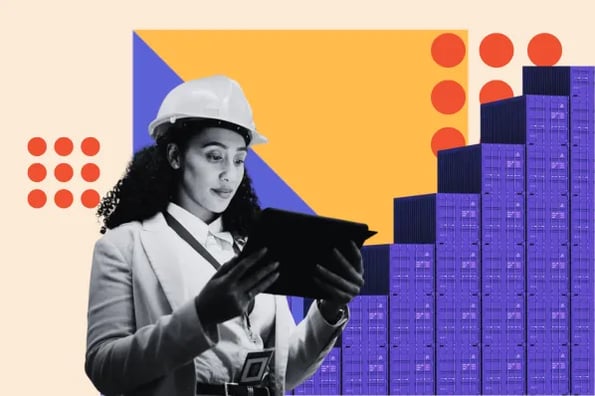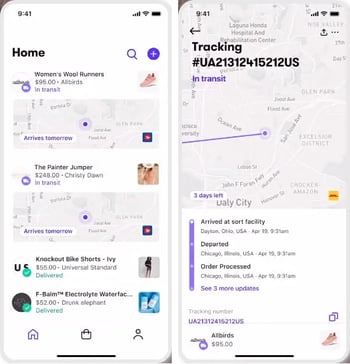Have you ever loved a product, went to purchase it online, and discovered it was out of stock? Or, even worse, have you bought an item and waited weeks for it to arrive, only for it to never show up? Experiences like these are the reason supply chain visibility is essential. As the former head of customer success for a startup developing supply chain visibility solutions, I learned firsthand just how vital it is.

![Access Now: Customer Support Strategy Template [Free Tool]](https://no-cache.hubspot.com/cta/default/53/7dff7d77-3a4c-40ea-a4c8-376b827a83ab.png)
Without visibility into the supply chain — that is, insight into whether products are in stock and when they will be delivered — your customers will get frustrated. They may even lose faith that they’ll ever get their orders. It’s a cause-and-effect situation — frustrated customers will cancel their purchases or shop elsewhere next time they need a product.
In this article, I’ll start by explaining what supply chain visibility is. Then, I’ll give an example of supply chain visibility and demonstrate why it substantially impacts customer experience. Finally, I’ll share how you can build supply chain visibility into your organizational fabric.
What is supply chain visibility?
Supply chain visibility refers to how easy it is for a business or customer to track the delivery of products or parts ordered online. When this information is available and accessible, it enables all stakeholders to have insight into when a product will be delivered or available for purchase. This ultimately drives a superior end-to-end customer experience.
What is the value of supply chain visibility?
Visibility into your company’s supply chain helps you understand when your products will be restocked so that you can promote them to your customer base. If you know that a popular product will be available soon, you can create a timely advertising campaign and spread the message to your customers.
At the same time, on the consumer side, supply chain visibility helps your customers know when a product they ordered will arrive at their front door — instead of being forced to wait around indefinitely.
If customers have to wait without an idea of when the product should be delivered, they may hesitate to return for another purchase, even if the product eventually arrives. This is especially true if they want it delivered quickly or need it by a specific date, such as a birthday or anniversary.
As Chief Supply Chain Officer for Land O’Lakes Yone Dewberry explains, “Customers may buy products, but what they are really buying is the entire experience. And that’s what they are judging a company on.”
To truly stand out (and avoid losing otherwise happy customers to an unexpectedly negative delivery experience), Dewberry argues that supply chain visibility is essential.
.png)
Free Customer Support Training Template
Train and onboard your new customer support hires with this downloadable template.
- Training Timeline
- People to Meet
- 100 Day Goals
- And More!
Supply Chain Visibility Example
So, what does this look like in practice? I’ll share a personal example of a supply chain visibility mixup that left me frustrated as a customer.
Last summer, I bought a canoe from an online retailer because it was on sale. Unfortunately, I later found out that the canoe was on backorder, and it wouldn't be delivered until after August. My dreams of traversing the great rapids of northern New Hampshire quickly faded as I packed away my paddles for next summer and waited until fall for my canoe to arrive.
The feeling of delight that I received from initially making the purchase was quickly negated by the company's poor supply chain visibility. While I was happy that I got a good deal, I wanted the canoe for this summer, not the next one.
Even though the canoe did eventually arrive, and I certainly appreciated the discounted price, the company did such a poor job communicating its product availability that I definitely won't return for another purchase. After all, how could I trust that the next order would be delivered in a timely manner?
Had the company simply communicated to me that the product was on backorder, this point of friction could have been avoided. I probably still would have bought the discounted canoe, but my expectations would have been appropriately set that it wouldn’t be delivered until the end of the summer. Moreover, my negative experience would have been replaced by proactive customer service, strengthening my relationship with the brand.
As you can see from this supply chain visibility example, it can make or break a customer’s experience with your company. Below, I’ll share seven strategies that I’ve found can help any brand improve its supply chain visibility — and avoid repeating my canoe-purchasing mishap.
How to Increase Supply Chain Visibility
- Map your supply chain network.
- Be proactive when sharing updates.
- Communicate often with suppliers.
- Offer shipping tracking.
- Provide real-time Shipping Updates.
- Partner With an Online Shopping Assistant.
- Gather Customer feedback.
.png)
Free Customer Support Training Template
Train and onboard your new customer support hires with this downloadable template.
- Training Timeline
- People to Meet
- 100 Day Goals
- And More!
1. Map your supply chain network.
To improve your brand’s supply chain visibility, you must first understand your own supply chain. That means making sure you have insight into how your supply chain works and where your company's resources are coming from.
The easiest way to do this is to start by mapping out all of your suppliers. Then, analyze how each one delivers its products or resources to your business and/or customers. Once you know how your products get made and delivered, you'll have an easier time giving customers visibility into your supply chain.
Rachel Hand, a Content Marketing Specialist for the e-commerce fulfillment company ShipBob, compellingly describes just how powerful supplier mapping can be.
“Supply chain mapping helps you understand where your products are coming from, and how different supply chain functions are accomplished — which, in turn, enables your e-commerce business to improve risk management and prepare for your future,”Hand says.
2. Be proactive when sharing updates.
When a problem affects your supply chain, it's essential to be proactive and communicate changes to your customer base. Don't wait for customers to reach out to your support team because they haven't received an order. Instead, contact them directly so they know that you’re aware of the issue and are working to deliver their purchase as soon as possible.
Indeed, as Gartner Analyst John Quaglietta explains,“Shifting from reactive to proactive conversations is a game-changer,”as it can help you with“delivering nearly effortless experiences, reducing cost, and increasing customer lifetime value.”
Proactive communication is critical in every aspect of the customer experience, but it’s especially important regarding supply chain issues.
To be clear, you don't have to share every detail. But you do need to let your customers know why shipping is delayed and when they can expect their product to be delivered. Remember, most customers will understand if you're transparent and reassuring — but if you don't tell them when they'll receive their order, they'll keep calling until they get an answer.
3. Communicate often with suppliers.
In my experience, I’ve found that the best way to know when a new shipment will arrive is to communicate often with your suppliers. If you forge strong relationships with these key partners, you’ll be empowered to confidently tell your customers when their purchases will arrive.
Moreover, when issues do affect your supply chain, you'll be one of the first to know, meaning you’ll have the information you need to share any updates or delays with your customers.
4. Offer shipping tracking.
If you’re an e-commerce brand, a great way to increase supply chain visibility is to add automated shipment tracking to your website, as in the example below:

This software lets your customers know exactly when their order is processed, shipped, and delivered to their front door. It also offers live tracking updates, describing where the product is for each step of the delivery process.
The example above shows the customer invaluable information, including when the package label was made when the shipping partner received it, and when it is in transit. They’ll be able to track each step of the process, which is attractive for customers craving communication from your brand about any delays.
5. Provide real-time shipping updates.
In addition to the live tracking illustrated in the last example, real-time shipping updates are another great way to let customers know when their orders will be delivered. Many businesses use SMS messages to send customers delivery updates, as in the example below:
.webp?width=350&height=623&name=amazon%20(1).webp)
As logistics app development expert Abrez Shaikh argues,“In today's e-commerce landscape, providing customers with accurate and up-to-date information about their deliveries is crucial for building trust and maintaining customer satisfaction.”
Real-time shipping updates are a great way to ensure that customers know exactly when they can expect their orders to arrive, and new technologies are making it easier than ever for companies to offer these increasing levels of supply chain visibility.
6. Partner with an online shopping assistant.
If you aren't able to offer in-house shipping tracking, another option is to leverage an online shopping assistant tool that can do it for you.
For example, Shop is an order-tracking app that ecommerce businesses can use to tell their customers when products are going to arrive. When customers buy something, their order information is forwarded to Shop, and then they can use the app to review expected delivery dates, tracking numbers, and previous purchases.
Shop can even map the delivery route, so your customers know exactly where an order is when it's marked "in transit" on the app. If your customers have notifications enabled, they can even get a push notification sent to their phone, signaling the product moving to its next step.

7. Gather customer feedback.
At the end of the day, customer success is all about the customer. As a customer success leader, I’ve learned that no matter what problem you're trying to solve, talking to your customers and gathering their feedback is a critical first step.
Especially when it comes to supply chain visibility, many companies might not be sure where to start. To identify the top opportunities for your organization to improve visibility into its supply chain, consider surveying your customers to see what kinds of new tools or information would be helpful to them.
This doesn’t have to be complicated: Once a product has been delivered to a customer, email them a simple NPS or CSAT survey. As part of this survey, ask customers where your business can improve its delivery process and what more your company can offer to support customers after they make a purchase.
.png)
Free Customer Support Training Template
Train and onboard your new customer support hires with this downloadable template.
- Training Timeline
- People to Meet
- 100 Day Goals
- And More!
Supply Chain Visibility Trends to Watch Out For in 2024
Of course, when it comes to customer experience, it’s important to stay on top of the shifting trends that drive consumers’ ever-shifting needs and expectations. In particular, there are three key trends within the supply chain visibility space that ecommerce businesses should be aware of.
Digital Transformation
First and foremost, the impact of digital transformation on the supply chain industry cannot be overstated. Gone are the days of analog tracking mechanisms and manual operations. Instead, the modern supply chain is increasingly digitized, with cloud-based systems and automated processes enabling stakeholders to keep better records and make data-driven decisions.
In fact, according to a recent report from Gartner, bringing digital transformation into the supply chain can lead to a 50% reduction in process costs and a 20% increase in revenue. Leaning into digital is the way to go in 2024 and beyond.
Improvement in Technology for Support Workers
Alongside the digitalization of global supply chain operations, new technologies are also influencing the experience of the warehouse workers and drivers that we all rely on to deliver goods to our doorsteps.
As Matthieu Kulezak — a Senior Analyst at the Internet of Things (IoT) market research firm IoT Analytics — explains, new technologies“will define the next era of digital supply chain as companies try to ensure their supply chains become more resilient, automated, and predictable.”
For example, robotic assistants can now speed up the process of moving products around a warehouse, RFID tags enable workers to easily scan packages, and GPS navigation tools can optimize drivers’ routes.
Especially as younger, more tech-savvy workers join the supply chain workforce, expectations and comfort levels with using these sorts of tools are set to continue to increase — and organizations that fail to adopt them run the risk of being left behind.
Nearshoring
Finally, as customers expect increasingly rapid delivery times, many organizations are choosing to nearshore their operations. In other words, they’re reducing shipping costs and times by partnering with delivery service providers that are geographically closer to their customers. This makes it possible to improve the customer experience while also keeping shipping costs low.
Former President of logistics company Redwood Mexico Troy Ryley describes the benefits of nearshoring perfectly.
“Everybody that had extended, long supply chains got clobbered during the pandemic, and one of the solutions is moving your location closer to your market,” Ryley reflects.“The advantage of shorter lead times increases cash-to-cash cycles and provides an edge that many shipping customers cannot match.”
Nearshoring can be a great way to cut costs while also ensuring your customers have as positive an experience as possible.
Don’t Underestimate the Value of Supply Chain Visibility
When we think about customer experience, we often focus largely on the product itself. But for many brands, the process of actually receiving the product in the mail can be just as important as (if not even more critical than) the quality of the product once it arrives.
Editor's note: This post was originally published in October 2020 and has been updated for comprehensiveness.










